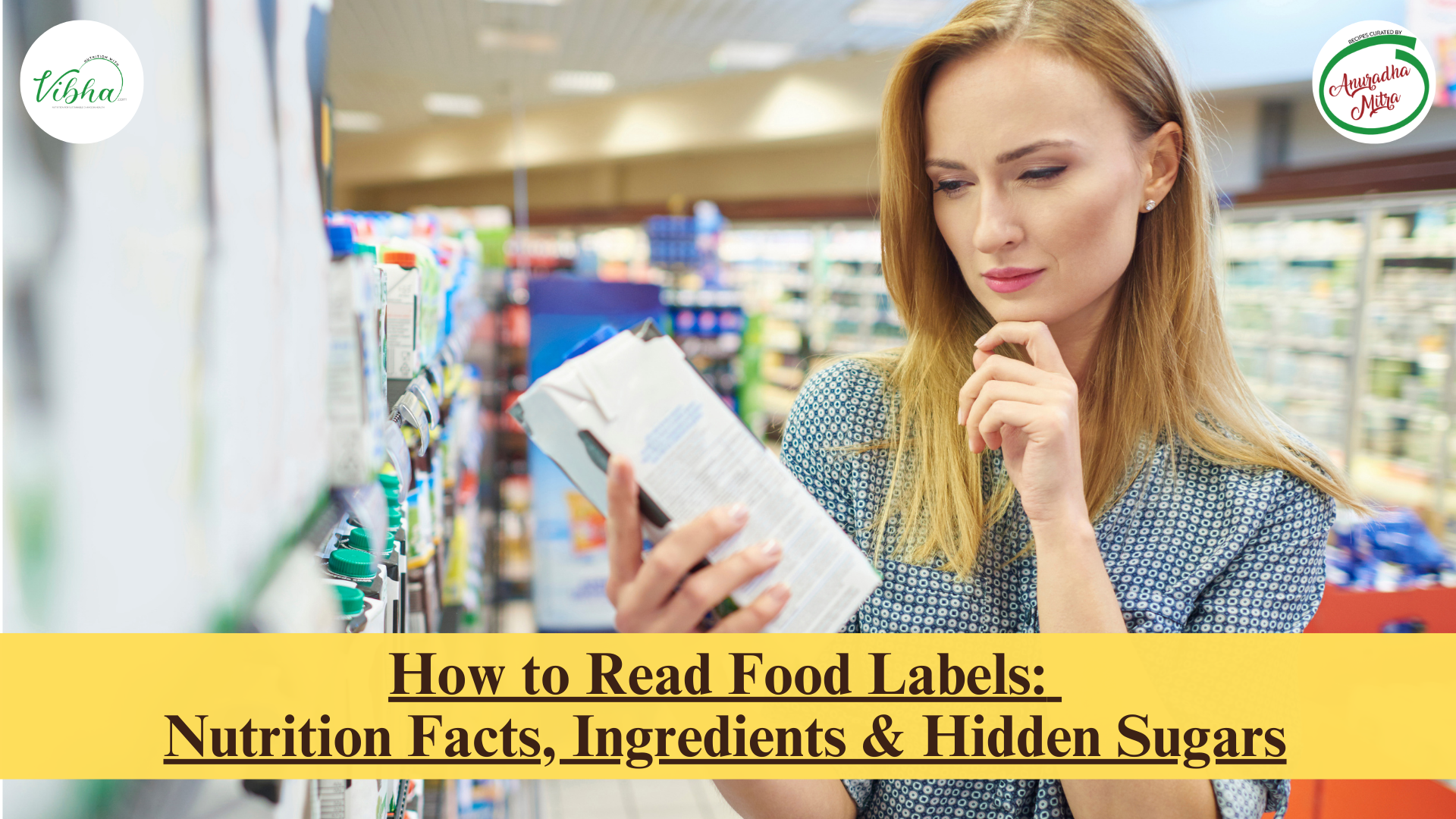How to Read Food Labels: Nutrition Facts, Ingredients & Hidden Sugars



A strong believer in the power of preventive and therapeutic nutrition, the role of holistic healing and the integration of Body, Mind and the Soul, Ms. Vibha Hasija is an academician (Department of Foods, Nutrition and Dietetics, College of Home Science, Nirmala Niketan, University of Mumbai) since 23 years. An expert in Clinical Nutrition and Dietetics and Nutritional Meal Planning, she is known for her powerful and highly effective teaching techniques in the field of Nutrition and Dietetics. She believes firmly in that – All changes happen first in the mind and this has been the guiding principle in her life as well as in applications in the field of Nutrition. Vibha has worked with her mentees in researching and creating Nutrition Communication Solutions and Educational Aids in the field of Clinical Nutrition which has won multiple awards including a National Award for Excellence in Innovation in Clinical Nutrition. She is a resource person for academic nutritional events and for talks on Health and Well Being. Associated with the Registered Dietitian Board of the Indian Dietetic Association as well as part of the executive committee of the Indian Association of Parenteral and Enteral Nutrition (Mumbai Chapter), she drives various nutrition education initiatives. An ardent poet and a prolific writer, she works to create a Health Mindset and make good health, good nutrition and lifestyle a human value. Through her Blog – Nutrition with Vibha, she is involved in making a positive difference to the nutritional and lifestyle choices of the community. With her mind on the multifaceted and multidisciplinary aspects of health and life, she brings her unique ideas to create a wave of Holistic Dietetic Choices. Through her unmistakable communication style of words and verses blended with evidence-based research, practicality and spiritual wisdom she dedicates herself to bettering the health of our Nation
Dr. Anuradha Mitra (Head of the Department of Foods, Nutrition and Dietetics, College of Home Science, Nirmala Niketan) holds more than three decades of experience in the field of Foods, Nutrition and Dietetics both as an academician as well as in the field of Community Nutrition. She has been the Chairperson of the Adhoc Board of Studies of Home Science and the Research Recognition Committee of the University of Mumbai and is highly appreciated as a wonderful and wise teacher who opens up minds to the varied aspects of Nutrition and builds up a desire in her students to better the community with their contributions at the grassroot level especially to the vulnerable and marginalized. Her pioneering work in the field of Adolescent Nutrition as part of her Doctoral Thesis, wherein she has made a detailed study of over 2000 adolescent girls in Mumbai has won the Mumbai University Gold Medal for exemplary research in ‘Avishkar’, the Inter-university Research Fest.
Her special passion and forte lies in Product development; creative recipes that are a blend of the delicious, and the nourishing… Her unique recipe conceptions, adaptations and innovations have made her a sought-out expert by various top brands like Kelloggs, Tata’s Heinz and so on as well as by Government Organisations like Integrated Child Development Services (ICDS) for the underprivileged. Along with being a resource person for academic events she has presented papers both at national and international level, and judged a number of Recipe competitions.
Dr. Anuradha Mitra enriches this venture with her special magic of being able to formulate recipes for the varied needs of individuals, keeping in mind the nutritional requirements, albeit laced with her special practical approach and her own brand of life and nutrition wisdom. She dedicates her expertise to empower the world to revel in the joys of nourishing and love filled cooking. She envisions creating homes with a bustling kitchen where all members of the family fall in love with food that nourishes and rise into good health and nutrition; it is this aim that pushes her to create more treasures of recipes that will both satiate the palate as well as nourish the body.
Wilfred Fernandes is a professional who has pioneered several innovations during his 14 year stint at the Bennett Coleman Company Group – the Times Property supplement being a fitting example,as well as the Chief Marketing Officer at Ekta World in the realty space.
Reputed for cutting through marketing clutter with fresh business approaches, he founded YOUNG (www.weareyoung.in) in 2010. His vision of and initiatives for an ongoing growth business momentum keeps his media venture YOUNG out of the league of its contemporaries.
This dynamic founder of YOUNG recognised the power and reach of the digital medium and collaborated in creating huge waves of change and empowerment in the community as well as business opportunities. He has thus upscaled and endeavours to launch several digital initiatives
His deep interest in Health, Wellness, Fitness and Sports has led to this confluence of credible nutrition content and a well thought of platform giving birth to nutritionwithvibha.com